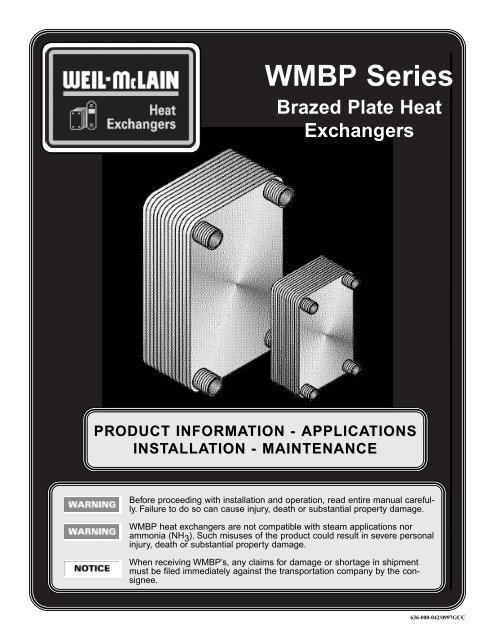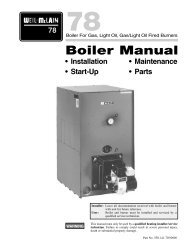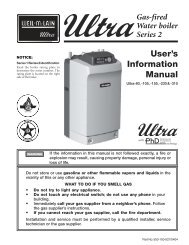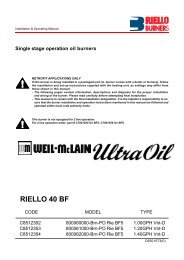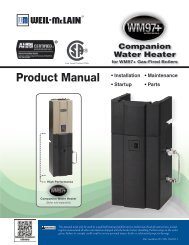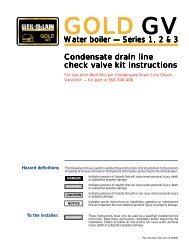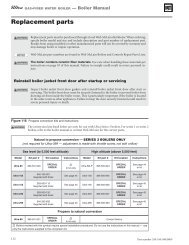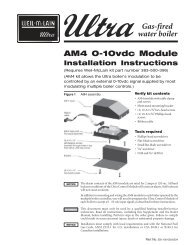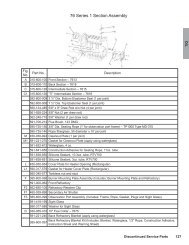Heat Exchanger Manual - Weil-McLain
Heat Exchanger Manual - Weil-McLain
Heat Exchanger Manual - Weil-McLain
Create successful ePaper yourself
Turn your PDF publications into a flip-book with our unique Google optimized e-Paper software.
WMBP Series<br />
Brazed Plate <strong>Heat</strong><br />
<strong>Exchanger</strong>s<br />
PRODUCT INFORMATION - APPLICATIONS<br />
INSTALLA<br />
ALLATION - MAINTENANCE<br />
Before proceeding with installation and operation, read entire manual carefully.<br />
Failure to do so can cause injury, death or substantial property damage.<br />
WMBP heat exchangers are not compatible with steam applications nor<br />
ammonia (NH 3 ). Such misuses of the product could result in severe personal<br />
injury, death or substantial property damage.<br />
When receiving WMBP’s, any claims for damage or shortage in shipment<br />
must be filed immediately against the transportation company by the consignee.<br />
636-000-042/0997GCC
READ THIS PAGE FIRST<br />
PRODUCT INFORMATION<br />
TABLE OF CONTENTS<br />
Description . . . . . . . . . . . . . . . . . . . . . . . . . . . . . . . . . . . . . . . . . .3<br />
Applications . . . . . . . . . . . . . . . . . . . . . . . . . . . . . . . . . . . . . . . . .3<br />
Technical Data . . . . . . . . . . . . . . . . . . . . . . . . . . . . . . . . . . . . . . . .4<br />
PRODUCT SELECTION<br />
Computerized Sizing . . . . . . . . . . . . . . . . . . . . . . . . . . . . . . . . . . .5<br />
Chart for Typical Floor <strong>Heat</strong>ing Applications . . . . . . . . . . . . . . . . .6<br />
Chart for Typical Snow Melt Applications . . . . . . . . . . . . . . . . . . .6<br />
Chart for Domestic Hot Water . . . . . . . . . . . . . . . . . . . . . . . . . . . .7<br />
INSTALLATION GUIDE<br />
General Information . . . . . . . . . . . . . . . . . . . . . . . . . . . . . . . . . . .8<br />
Piping Connections . . . . . . . . . . . . . . . . . . . . . . . . . . . . . . . . . . . .8-10<br />
MAINTENANCE<br />
SUBMITTAL<br />
HAZARD DEFINITIONS<br />
The following terms are used to bring attention to the presence of hazards of various risk levels or<br />
to important information concerning product life.<br />
Indicates presence of hazards that will cause severe personal injury, death or<br />
substantial property damage if ignored.<br />
Indicates presence of hazards that can cause severe personal injury, death or<br />
substantial property damage if ignored.<br />
Indicates presence of hazards that will or can cause minor personal injury or<br />
property damage if ignored.<br />
Indicates special instructions on installation, operation, or maintenance that are<br />
important but not related to personal injury hazards.Read all instructions before<br />
installing. Failure to follow all instructions in proper order can cause severe<br />
personal injury, death or substantial property damage.<br />
Fouling/Cleaning . . . . . . . . . . . . . . . . . . . . . . . . . . . . . . . . . . . . . .11<br />
Submittal . . . . . . . . . . . . . . . . . . . . . . . . . . . . . . . . . . . . . . . . . . . .12Mod<br />
2
PRODUCT INFORMATION<br />
<strong>Weil</strong>-<strong>McLain</strong> WMBP brazed plate heat exchangers<br />
are designed with up to 150 pattern - embossed<br />
plates of acid resistant stainless steel. The plates are<br />
brazed together, with every second plate inverted to<br />
create contact points between all the plates. When<br />
these points are vacuum brazed together a compact<br />
and pressure resistant heat exchanger is formed in<br />
which virtually all material is utilized for heat transfer.<br />
High Efficiency<br />
Description<br />
The design of the plates creates two separate<br />
channels for a counter flow movement. This<br />
complex channel system results in high turbulence<br />
and thereby high heat transfer characteristics.<br />
Non Corrosive<br />
The plates are made of stainless, acid resistant<br />
steel, with 99.9% pure copper and are brazed,<br />
which ensures a very high resistance to corrosion.<br />
Self Cleaning<br />
The WMBP heat exchanger operates with a turbulent<br />
flow, even at low velocities, creating a<br />
self cleaning, self descaling design that resists<br />
scaling.<br />
Applications<br />
District <strong>Heat</strong>ing<br />
Schools<br />
Hotels - Restaurants<br />
Hospitals<br />
Apartment Buildings<br />
Governmental Buildings<br />
Industrial Buildings<br />
Sport Complexes<br />
Boiler Manufacturers<br />
Nursing Homes<br />
Manufacturing Plants<br />
Radiant Floor <strong>Heat</strong>ing<br />
Snow Melting<br />
Domestic Hot Water<br />
<strong>Heat</strong> Recovery<br />
<strong>Heat</strong>ing Systems<br />
Industrial Processes<br />
Oil Cooling<br />
Etc.<br />
3
PRODUCT INFORMATION<br />
Technical Data<br />
Fig.: 1<br />
Operating Conditions:<br />
Max. working pressure<br />
Max. working temperature<br />
Min. working temperature<br />
: 450 psig<br />
: 365º F<br />
:-320º F<br />
Standard Connections<br />
N= Number of Plates<br />
* The maximum working pressure for the<br />
WMBP-1E series is 150 psig.<br />
4
PRODUCT SELECTION<br />
Computerized Sizing<br />
With our computer program we will select the optimum heat exchanger for your particular applications.<br />
Please fax this selection sheet back to our Engineering Department. You may request a copy of our software<br />
package, courtesy of <strong>Weil</strong>-<strong>McLain</strong>. Contact us at: Phone (219) 879-6561 or Fax (219) 877-0556<br />
Submit this information to <strong>Weil</strong>-<strong>McLain</strong> for<br />
computerized sizing assistance. Our program<br />
will select the optimum heat exchanger<br />
for your particular application.<br />
Date:<br />
Name:<br />
Company:<br />
Fax#:<br />
Job ref.:<br />
Application:<br />
Fax Back Selection<br />
Hot Side<br />
Cold Side<br />
Media Water Water<br />
Glycol Glycol <br />
% %<br />
Flow Rate GPM GPM<br />
Temp. In DEG F DEG F<br />
Temp. Out DEG F DEG F<br />
Max Pressure Drop PSI PSI<br />
Capacity Btu/h<br />
WMBP Brazed Plate <strong>Heat</strong> <strong>Exchanger</strong> Design Data<br />
OUR SELECTION: Type of <strong>Heat</strong> <strong>Exchanger</strong>:__________________________<br />
Hot Side<br />
Cold Side<br />
Media Water Water<br />
Glycol % Glycol %<br />
Flow Rate GPM GPM<br />
Temp. In DEG F DEG F<br />
Temp. Out DEG F DEG F<br />
Max Pressure Drop PSI PSI<br />
Capacity Btu/h<br />
5
PRODUCT SELECTION<br />
For Typical Floor <strong>Heat</strong>ing Applications<br />
For Typical Snow Melt Applications<br />
6
PRODUCT SELECTION<br />
For Domestic Hot Water<br />
High Performance<br />
The WMBP compact size and light weight will reduce the time required to heat the tap water by 50% over<br />
conventional heat exchangers.<br />
7
INSTALLATION GUIDE<br />
WMBP heat exchangers should be installed in such<br />
a way that there is sufficient free space around each<br />
unit to perform maintenance work.<br />
Mounting Position<br />
General Information<br />
for special piping to meet double wall requirements<br />
when necessary.<br />
Flush the piping circuits thoroughly before connecting<br />
the heat exchanger to prevent blockage from<br />
debris in the piping.<br />
Provide shut off valves and any other devices<br />
required for operation and safety. In addition we<br />
recommend an air vent on the top and a drain valve<br />
at the lower connection.<br />
Fig. 2<br />
For heating applications the plate heat exchanger can<br />
be installed in any position. The primary side is identified<br />
by a red label.<br />
Support the heat exchanger by a<br />
bracket. Do not support the<br />
WMBP unit by the fittings.<br />
Support all items independently. Provide vibration<br />
isolation between the heat exchanger and the mounting<br />
brackets. Failure to properly support the heat<br />
exchanger can result in severe personal injury, death<br />
or substantial property damage.<br />
Fig. 3 Typical <strong>Heat</strong>ing Application<br />
Connect the piping in counterflow as shown, with<br />
the primary piping on the side of the red dot.<br />
WMBP heat exchangers may have<br />
some sharp edges. Handle the unit<br />
with care to avoid the risk of<br />
severe personal injury, death or substantial property<br />
damage.<br />
Piping Connections<br />
All piping connections to WMBP heat exchangers<br />
are male NPT.<br />
Alway connect the primary piping to the red dot side<br />
of the WMBP heat exchanger. Make sure the piping<br />
is arranged for counterflow as shown in Figures 3<br />
and 4 for normal heating applications. See Figure 5<br />
Fig. 4 Typical Series Piping Arrangement<br />
Use series piping when needed to increase the thermal<br />
length.<br />
8
INSTALLATION GUIDE<br />
Vent the Air During Filling<br />
Vent the heat exchanger(s) during filling to eliminate<br />
any trapped air to assure proper performance and<br />
longevity of the heat exchanger.<br />
Shutting Down the <strong>Heat</strong> <strong>Exchanger</strong><br />
Shut down both sides of the piping system slowly<br />
and at the same time. If this isn’t possible, shut the<br />
hot side down first.<br />
Drain and clean the heat exchanger if it will be shut<br />
down for a long time. This is very important where<br />
there is a risk of freezing or where the water is particularly<br />
corrosive.<br />
Fig.. 5 Typical Double Wall Piping<br />
This piping arrangement can be used to provide<br />
double wall heat exchange. The recirculation loop<br />
provides isolation between the two exchangers.<br />
Fig.. 6 Typical Snow Melting Applicationl<br />
9
INSTALLATION GUIDE<br />
Fig.. 6 Typical Instantaneous Domestic Water <strong>Heat</strong>ing Application<br />
Fig.. 6 Typical Domestic Water <strong>Heat</strong>ing Application Using a Storage Tank<br />
10
MAINTENANCE<br />
Different factors may effect fouling, ie: fluid velocity,<br />
temperature, turbulence, flow distribution, surface<br />
finish and water quality.<br />
Types of fouling<br />
Scaling:<br />
Deposits of calcium on the heat transfer surface,<br />
increases with temperature higher than 160ºF,<br />
and concentration and pH.<br />
A turbulent flow and lower temperature may<br />
help reduce the deposit.<br />
Particles:<br />
Fouling/Cleaning<br />
Solids in suspension in the heat transfer fluids.<br />
Such fouling can be influenced by velocity and<br />
fluid flow, roughness of the heat transfer surface<br />
and dimensions of the particles.<br />
Proper maintenance and adequate treatment of the<br />
water should reduce the risk of fouling. Strainers,<br />
properly sized and located, should be provided. A<br />
mesh size of 16-20 mesh will retain any particle<br />
above 1mm.<br />
Cleaning:<br />
Clean the heat exchanger periodically if water<br />
quality is poor or hardness is high. Flush strainer,<br />
clean filters and back flush periodically.<br />
A light solution (5% concentration) of phosphoric<br />
acid or any other acid which will not attack<br />
copper or stainless steel should be used to flush<br />
the unit.<br />
Use extreme caution when<br />
handling acid or other corrosive<br />
chemicals to avoid risk of<br />
severe injury, death or substantial<br />
property damage.<br />
NOTE<br />
<strong>Weil</strong>-<strong>McLain</strong> reserves the right to make any changes in details of design, construction, arrangement or materials<br />
as shall in its judgment create an improvement.<br />
Made in Germany by WTT<br />
11


